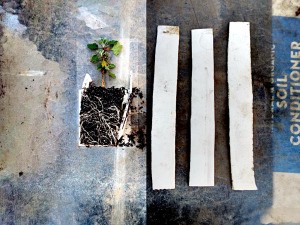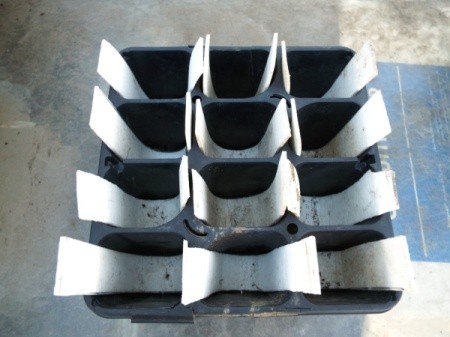 The majority of seedlings and cuttings I start indoors are in homemade paper pots. The advantages of these pots are that they are free and you can plant the whole pot, paper and all.
The majority of seedlings and cuttings I start indoors are in homemade paper pots. The advantages of these pots are that they are free and you can plant the whole pot, paper and all.
Even so, I do find many occasions to reuse cell packs that once held bedding plants at garden centers. I've reused these cell packs for years. I have seen them go from sturdy and lasting 2-3 years, to extremely flimsy and so thin it's hard to get the original plants from the cells without tearing both the cell pack and the plant roots.
Not to be outdone, I still use the cell packs, even if I have to nest 2 or 3 together. Usually, my plants have such a mass of healthy roots, it's hard to get them from the cell pack without tearing many of the roots that stick to the side walls of the cell pack.
I have come up with a solution to this problem. I insert strips of material into the cells before filling them with soil. When it comes time to transfer the plants from the cell pack to the garden, the plants and all the roots are easily removed from the pack with just a gentle tug on both ends of the strip.
It takes a bit of time to cut these strips, but I save more time and aggravation by using them. There's no mess from having to knock the plant from the pack.
The material I used here is a sheet foam that would not be available to most of you. I had it on hand and it lasts about 5 years, so I used it. I have used various other materials. Rather than tell you what they are, I hope to hear suggestions from you as to what you think would make good strips. I'm always looking for something different to try.

Looks and sounds like a good idea as you are right about the stability of the cell packs. I used to pick these up at our local recycle spot but most are just thrown away now.
I'll have to think about what material I have on hand that will be suitable (and not rot in a few days).
As always, Thanks for a useful suggestion.
What a great idea. I think interfacing left over from sewing projects would work nicely.
Would you believe I worked in the garment industry for 10 years and I don't know the composition of interfacing. If it's of nylon, it may work very well. Which brings an idea to mind. You could use strips cut from landscape fabric.
Would you believe I worked in the garment industry for 10 years and I don't know the composition of interfacing. If it's of nylon, it may work very well. Which brings an idea to mind. You could use strips cut from landscape fabric. It would have to be the nylon and not the plastic type. I'm digging up the nylon type that has been in the ground for 20 years. It's as strong as ever. Thanks for putting my noggin to work!